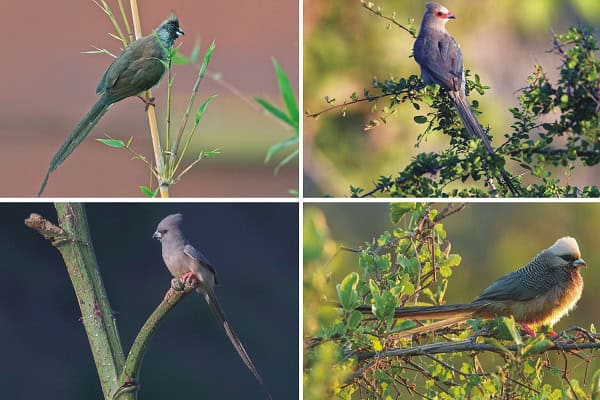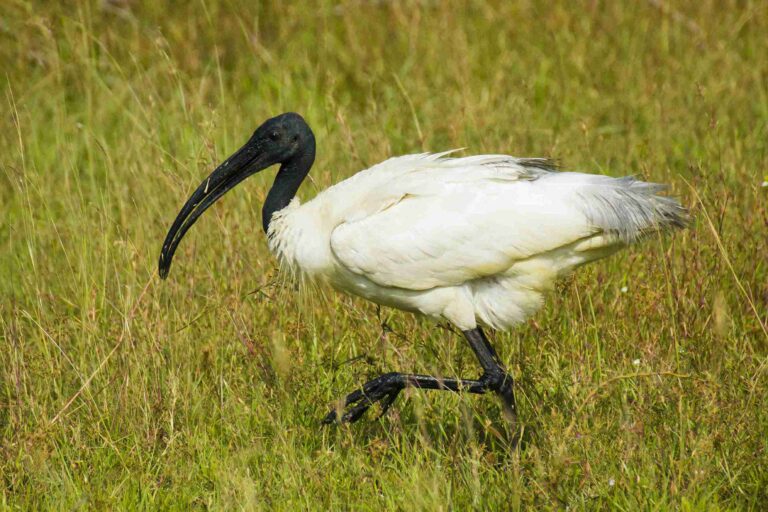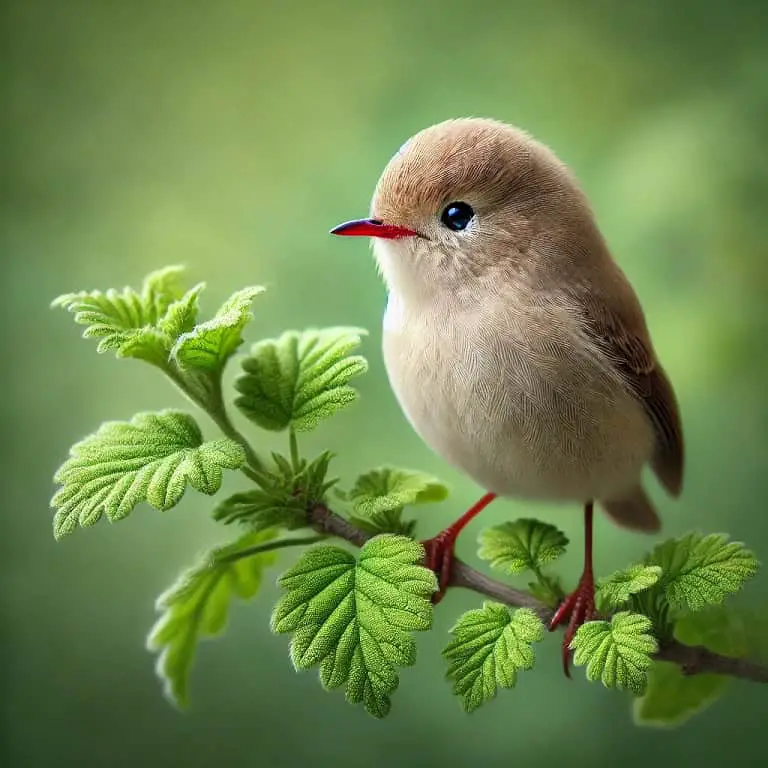Mousebirds (Family Coliidae): Unique African Birds with Photos
Have you ever thought about what makes some birds truly stand out? In Africa, mousebirds are a prime example of this uniqueness. They are known for their amazing acrobatic skills and special traits. These birds belong to the Coliiformes order and are found only in sub-Saharan Africa.
There are six different mousebird species, each with its own set of fascinating features. They have caught the attention of bird experts and fans. Let’s take a closer look at these remarkable birds. We’ll explore their taxonomy, physical traits, where they live, what they eat, how they interact with others, their nesting habits, and their conservation status.
Introduction to Mousebirds
Mousebirds, also known as Colies, are a fascinating group of birds from sub-Saharan Africa. They are small and agile, living in the lush landscapes of the region. They stand out with their long tails and colors that blend in with leaves and branches.

These birds move carefully as they look for food. They use this caution to move through thick vegetation. They eat fruits, flowers, and leaves. Their ability to climb and perform acrobatics makes them a joy to watch.
Learning about mousebirds shows us how amazing these African birds are. Their unique behaviors and looks capture our attention. They help us understand the rich variety of life in Africa.
Taxonomy of Mousebirds
The Taxonomy of Mousebirds shows a unique group within the Coliiformes order, found only in Africa. They are part of the Coliidae family, with two main groups. This shows they are closely related to parrots and cockatoos. By looking at species classification, we see six different Mousebird species: Red-backed, Speckled, White-backed, White-headed, Blue-naped, and Red-faced.
This grouping helps us understand their evolution. Here are the main points of their taxonomy:
| Species Name | Scientific Name | Distinct Features |
|---|---|---|
| Red-backed Mousebird | Urocolius indicus | Known for its bright red back and long tail. |
| Speckled Mousebird | Colius striatus | Has speckled feathers and lives in groups. |
| White-backed Mousebird | Colius colius | Easy to spot with its white back and lives in cities. |
| White-headed Mousebird | Colius leucocephalus | Has a white head and a cream body. |
| Blue-naped Mousebird | Urocolius macrourus | Has a blue patch on its neck. |
| Red-faced Mousebird | Urocolius indicus | Stands out with its bright face. |
Learning about the Taxonomy of Mousebirds helps us value their role in Africa’s ecosystems. Each species has special traits that add to the area’s bird diversity.
Unique Physical Characteristics
Mousebirds have some amazing physical traits that help them live in the trees. Their looks and features make them stand out from other birds. These traits also help them adapt to their surroundings.
Body Shape and Size
The mousebird’s body is a bit chunky, with long tails and sharp crests. These features give them great balance and agility in the trees. They are about 11 to 15 inches long, including their tails, and their body is around 3.9 inches long.
This size lets them move quickly and easily through their environment.
Feather Characteristics
Mousebirds have feathers that look a lot like a mouse’s fur. This is why they are called mousebirds. Their feathers are soft and help them blend in with their surroundings.
This makes it easier for them to find food among the leaves without being seen by predators.
Toe Arrangement and Adaptation
Mousebirds have a special way of arranging their toes called pamprodactyl. All four toes point forward, which is perfect for hanging upside down while eating. This helps them feed and climb through the trees.
Their unique toes show how important their physical traits are for surviving and living in their environment.
Habitat and Distribution
Mousebirds live in unique places across Africa. They are found in many different types of ecosystems. Let’s look at where they live and the environments they like.
Geographic Range in Africa
Mousebirds live in sub-Saharan Africa. They are common in countries like Angola, South Africa, Tanzania, and the Democratic Republic of the Congo. They can live in many places because they can adapt to different climates.
This shows how well they can live in various habitats. They are often seen in these areas.
Typical Environments
Mousebirds like to live in:
- Woodlands
- Savannahs
- Thickets
- Agricultural lands
- Forest edges
These places have lots of plants and food, which they need to survive. They can live in many different places, showing how adaptable they are.
Diet and Feeding Behavior
Mousebirds have a fascinating diet that shows their unique eating habits. They mainly eat plants, which is key to their survival and behavior in the wild.
Food Preferences
Mousebirds love to eat fruits, berries, leaves, and seeds. Their diet includes:
- Berries from various shrubs and trees
- Fruits, particularly those that are soft and ripe
- Green leaves that provide essential nutrients
- Seeds, offering a hardiness to their diet
This variety of food keeps them energized and supports their foraging behaviors.
Feeding Techniques and Acrobatic Skills
Mousebirds are famous for their amazing acrobatic skills. These skills help them get food from hard-to-reach places. They hang upside down to eat food that others can’t get to.
Their strong feet let them hold onto branches easily while they forage. This shows how well they move through their environment to find food. It highlights their smart relationship with their habitat.
The mix of their varied diet and impressive skills shows how adaptable and smart they are. Watching them move through their world is truly captivating.
Nesting Habits of Mousebirds
Mousebirds have unique nesting habits that show their special behavior and adaptations. They build nest types that are interesting and show how they work together. By looking at their nesting, we see how they make safe places for their babies.
Types of Nests
Mousebirds make nests that are shaped like cups. They use different materials, including plants and even animal products. This makes their nests strong and hidden in thick leaves. This spot keeps the eggs safe and in a good climate.
Breeding Patterns and Clutch Size
Mousebirds are known for nesting together. Many females work together to take care of the nest. This nesting behavior helps them raise their young. They can have from one to seven eggs, showing how they adapt to different places.
| Nest Type | Materials Used | Typical Location |
|---|---|---|
| Cup-shaped | Plant materials, animal products | Dense foliage |
| Communal Nests | Varied plant fibers | Among branches or shrubs |
Looking at mousebird nesting habits shows us their complex social lives and how they reproduce. Their nest types and how they breed paint a detailed picture of these agile birds.
Social Behavior in Mousebirds
Mousebirds show interesting social behavior that is key to their lives. They often eat together, which helps them find food better and build strong friendships. They also groom each other, which is important for their social life.
Mousebirds like to roost together, sharing body heat to stay warm at night. This is very helpful in places where it gets cold. Roosting together helps them survive and feel like they belong.
- Group feeding: Enhances foraging success.
- Mutual preening: Strengthens social bonds.
- Communal roosting: Conserves energy and provides warmth.
These social habits show how important it is for mousebirds to be social. They make these birds very interesting to watch in the wild.
Species of Mousebirds
Mousebirds are a fascinating group of birds, with six recognized species. Each species has unique traits that show their adaptations and behaviors. This overview helps us see their uniqueness and the interesting aspects of mousebird life.
Overview of the Six Species
The mousebird species include the Red-backed, Speckled, White-backed, White-headed, Blue-naped, and Red-faced Mousebirds. Each species stands out for its size, color, and sounds. These traits help mousebirds live well in their African habitats.
Key Traits of Each Species
Let’s look at the main traits of each mousebird species:
| Species | Key Characteristics | Habitat | Vocalization |
|---|---|---|---|
| Red-backed Mousebird | Notable reddish-brown back, long tail | Savannas and open woodlands | High-pitched, chattering calls |
| Speckled Mousebird | Varied plumage with speckle patterns | Forests and shrublands | Melodic whistles |
| White-backed Mousebird | Pale gray body, white back | Wooded areas, gardens | Soft trills |
| White-headed Mousebird | Distinctive white head, athletic build | Dry scrub and thorny bush | Variable vocalizations |
| Blue-naped Mousebird | Colorful blue nape, overall greenish tinge | Coastal scrub and forests | Chirps and whistles |
| Red-faced Mousebird | Striking red face, elongated tail | Tropical and subtropical regions | Clear, sharp calls |
Conservation Status of Mousebirds
Learning about mousebirds’ conservation status shows us how important they are and what we must do to protect them. Most mousebird species are stable and are considered of least concern by the International Union for Conservation of Nature (IUCN). This is good news for their survival.
Population Trends
Most mousebird species have steady populations in their homes. Their numbers stay the same, showing they adapt well to their surroundings. But, we need to keep watching them to make sure they stay this way. Conservation efforts are key to keeping their populations healthy for the future.
Threats to Their Survival
Even though mousebirds are generally safe, they face threats that could change their future. Habitat loss from cities and farms is a big problem. Human actions like more land use and changes in the environment also hurt them. Plus, the pet trade can harm certain mousebird groups. We must tackle these issues to help mousebirds thrive in our changing world.
Acrobatic Skills of Mousebirds
Mousebirds are not just interesting because of how they look. They are also known for their amazing acrobatic skills. They can hang upside down, twist, and glide through branches to find food. This makes them stand out as aerial performers.
Their strong feet and special toes help them climb and grip branches easily. Watching a mousebird move is a sight to behold. It shows off their agility and how they adapt to their surroundings.
Some highlights of their acrobatic behavior include:
- Hanging upside down to forage for fruits and insects.
- Performing intricate maneuvers as they chase after insects in mid-flight.
- Effortlessly shifting between perches, showcasing agility in every movement.
Mousebirds use their acrobatic skills to survive and thrive in their environment. Their survival depends a lot on their agility. This makes them fascinating to nature lovers and scientists.
Mousebirds and Human Interaction
Our relationship with mousebirds shows how adaptable and resilient they are. These birds have learned to live well in human-made environments. They can be seen in cities, gardens, and even at bird feeders, showing how they adjust to our world.
Adaptation to Human Environments
Mousebirds and humans have learned to live together. These birds do more than just survive; they thrive in cities. They eat from gardens and parks, showing how they adapt and behave cleverly.
Pet Trade Concerns
The rise in mousebirds as pets brings up big concerns for their future. Even though they’re not endangered, taking them from the wild for pets is a big issue. We need to encourage responsible pet ownership and teach people about their need to protect mousebirds in the wild.
Common Misconceptions about Mousebirds
Many myths surround mousebirds, making them hard to understand. People often think they’re related to other birds, which is not true. They also believe mousebirds only eat fruit, but they eat leaves and flowers too.
Some think mousebirds live alone, but they have complex social lives. They live together and interact in interesting ways. This misconception makes us miss out on their social nature.
- They are not related to doves or pigeons despite their appearances.
- Mousebirds can engage in impressive acrobatic maneuvers beyond just perching.
- Their vocalizations are diverse and significant for communication.
- Mystifying nesting behavior often leads to misunderstandings about their reproductive habits.
Learning about these misconceptions helps us see mousebirds in a new light. By understanding the truth, we connect more with the wildlife around us.
Read My Previous Articles
| 14 Ways to Create a Bird-Friendly Garden and Yard |
| Owls in Ohio |
| What Do Rooks Eat |
| Black and White Birds |
| How Long Do Wood Pigeons Live? |
Conclusion
Mousebirds are truly fascinating birds known for their amazing acrobatics and special traits. They live in groups and have learned to adapt to many different places, even those changed by humans. This shows how well they have evolved to survive.
Learning more about mousebirds helps us see why we need to protect their homes. It’s important to understand their role in nature so we can work to save them. By learning about their unique qualities, we help everyone see why we must protect our planet.
Studying mousebirds teaches us to value the beauty of nature and how all living things are connected. Let’s keep watching and learning from these amazing birds. This way, we make sure they and their beauty will be around for future generations to enjoy.







